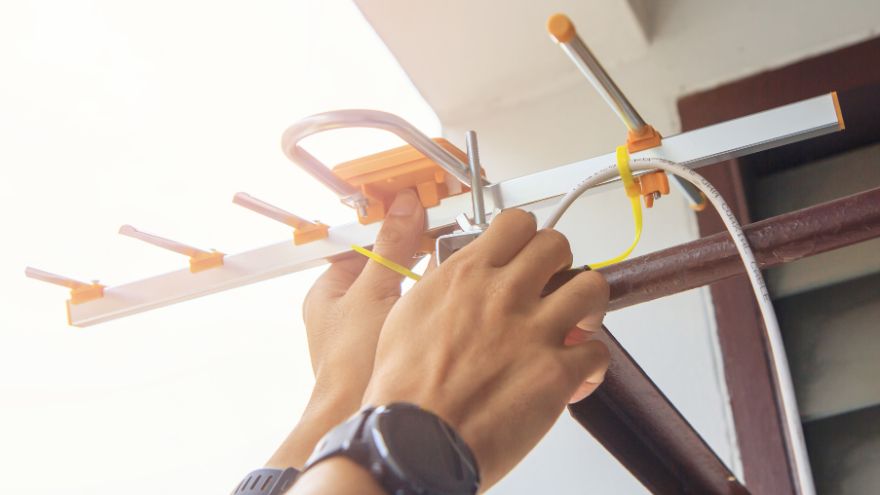Installing a terrestrial antenna requires proper preparation. Especially if these are external antennas, which are exposed to difficult conditions due to their location. Where is the best place to set up the antenna and how should it be attached to get the best signal?

Check out the outdoor antennas at the Onninen wholesaler
Where is the best place to place an outdoor and indoor antenna?
Choosing where to mount the internal and external antenna is crucial to enjoying a good quality signal. It is best to place internal antennas near a window, on a windowsill or on the glass thanks to special suction cups that facilitate installation. This location allows you to reduce any interference that may be caused by walls.
 If possible, it is best to place an indoor antenna on higher floors so that buildings, trees or other objects do not obstruct the signal. An indoor antenna cannot be placed right next to metal objects, large furniture or electronic devices, as they can interfere with signal reception.
If possible, it is best to place an indoor antenna on higher floors so that buildings, trees or other objects do not obstruct the signal. An indoor antenna cannot be placed right next to metal objects, large furniture or electronic devices, as they can interfere with signal reception.
The installation of an external antenna depends largely on the type of building. A single-family house offers the greatest possibilities, in which case it is best to install the antenna on the roof, as the highest point of the building. This reduces the risk of interference from other objects. When it is not possible to install it on the roof, a balcony is also a good solution. If possible, the external antenna is always installed at the highest level. When installed on the ground , the external antenna is best placed on a specially prepared mast.
In both variants, the height of the installation plays a major role. As a rule, the higher the better, as it helps avoid problems related to signal interference.
How to properly attach the antenna so that it always receives good reception?
When planning the antenna installation, you need to find the optimal place to mount it. Regardless of whether it is an outdoor or indoor model, it is good to know in which direction the transmitter is located. Pointing the antenna towards it often allows you to improve the signal quality. The second equally important issue is distance. If the transmitter is located far away, you may need an antenna with a signal amplifier.
 When choosing an external antenna, you need to remember that it will be exposed to harsh weather conditions. Wind can be a big problem, and if the antenna is not attached firmly enough, it can be damaged by strong gusts.
When choosing an external antenna, you need to remember that it will be exposed to harsh weather conditions. Wind can be a big problem, and if the antenna is not attached firmly enough, it can be damaged by strong gusts.
Regardless of whether it is attached to a building wall, balcony, roof or specially prepared mast, it must be resistant to strong gusts, and the mounting bracket must support the weight of the antenna itself. Stable mounting is also important in the context of safety. Attaching the antenna to unstable elements can cause it to break off and pose a threat to the safety of people nearby.
To mount the external antenna, additional elements and mounting accessories will be necessary. The appropriate set depends on the mounting location. A mast or a special antenna mount will be needed for the connection. Solutions made of corrosion-resistant materials will work best. This is often galvanized steel - durable and stable. In addition, expansion bolts and screws will be needed, and their size and type will depend on the surface to which the antenna and mounting will be attached. Other solutions are designed for concrete, others for wood or brick. In addition, you should also purchase special mounting bands.
External antennas are connected to the TV via a special antenna cable. In order for it to function properly for as long as possible and provide better signal reception, it must be properly secured. It is best if it is stably attached, for example, to an antenna mast. If it hangs freely, it can quickly become damaged, and then signal reception will be impossible.
If the signal is to power multiple receivers in the house, an antenna splitter will be necessary so that each television set can operate independently and there is no need to install multiple antennas.
Direction and angle for antennas: how to do it?
 Connecting the antenna is the first step, then it must be properly set. The setting of the terrestrial antenna must take into account the direction and angle so that the TV signal is as good as possible. Mesh antennas should always be set in the direction of the transmitter. To obtain the best parameters, it is best to use a special meter, and if this is not possible, you can also observe the signal quality directly on the TV.
Connecting the antenna is the first step, then it must be properly set. The setting of the terrestrial antenna must take into account the direction and angle so that the TV signal is as good as possible. Mesh antennas should always be set in the direction of the transmitter. To obtain the best parameters, it is best to use a special meter, and if this is not possible, you can also observe the signal quality directly on the TV.
If the distance between the antenna and the transmitter is large, then a special antenna amplifier may be needed to improve the strength and quality of the signal. The proper angle of inclination is also very important. Here, too, a special meter or a gradual change of angle and observation can be useful.